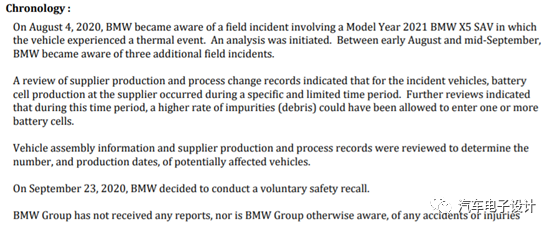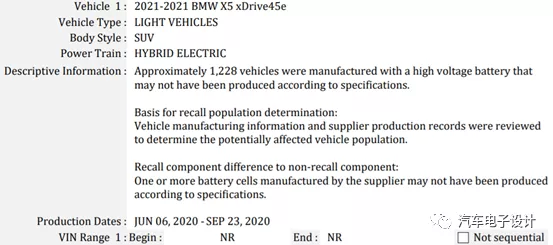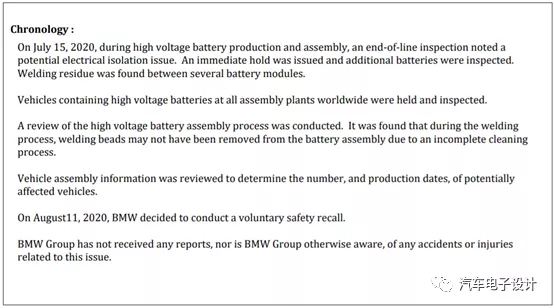Introduction
I’ve been busy with business trips these days and haven’t had time to sit down. Now, on my way home, I have some time to carefully sort out the information released by BMW regarding the PHEV recall. Based on the information published by the US NHTSA, the problem can be further attributed to some battery cell issues, which is different from the previous description. It’s said that impurities with a high proportion could be found in battery production and process adjustments, from welding slag to battery cell production, and BMW acknowledged in the document that four vehicles did catch on fire.
Traffic Data in the United States
1) “Part 573 Safety Recall Report 20V-601” issued on September 30
It is described in this document that the impact of the fire is huge. Therefore, BMW recognizes the need for a recall from the perspective of their own work and differences in supplier processes and process change reviews.

Almost all PHEV are involved, and the basic description is that some battery cells are not produced according to BMW’s requirements.

The battery cell supplier is Samsung SDI.

It should be noted that these are two different recalls of different scopes. Even BMW is not sure whether they need to be handled simultaneously. I feel that this is a traceable process. The previously discovered “Part 573 Safety Recall Report 20V-490”

2) “Part 573 Safety Recall Report 20 V-490”
This was released on September 2, which is the issue related to module welding process and nothing to do with battery cells.

In this previous description, potential insulation issues were discovered through the EOL inspection, from which it was inferred that there may have been a problem previously.
 ## Unemployment Rate
## Unemployment Rate
After the release of the interim conclusion, European customers will further focus on the existing suppliers SDI and LG Chem. In this regard, the previous situation where European customers uniformly used Korean battery cells on a large scale will be accelerated to break. Several European auto companies will advance the progress of developing suppliers. In fact, we can see the following picture:
1) Maintaining 2-3 battery suppliers in a region is necessary. For example, the situation of Ford KUGA PHEV recall, which resulted in its failure to meet the requirements of carbon emissions and needed to be merged for calculation, is a painful case.
2) At present, opportunities for Chinese battery suppliers in Europe may be faster than previously thought, and the transfer of orders to Europe is estimated to be a matter of 2022, but now it may be advanced to 2021. Of course, according to the investigation method of European auto companies’ problems, the impact on the next iteration of battery chemistry systems is likely to be far-reaching. This is because European auto companies are about to enter a cycle of NCM 811 application, and if impurities have such a large impact on the low energy density battery cells of PHEVs, it can be expected that the impact of impurities on the battery cells of BEV models will be even greater.
In fact, when vehicles are widely used in Europe, similar problems as in China will also be faced due to the deployment of more than 1 million units in Europe in 2020. It’s just that the tolerance of European auto companies and regulators for such small probability events is very low, so there is a process to follow.
Conclusion
To be honest, the current investigation results do not mean that the situation in China is much better than in Europe. It’s just that European auto companies have more adequate information disclosure, and we can understand their problems from official channels. For the rapid growth of the industry, high energy density, low cost, and large-scale deployment, it is impossible to completely eliminate the low probability of thermal runaway problems in the short term. There is no safety myth for making power batteries.
This article is a translation by ChatGPT of a Chinese report from 42HOW. If you have any questions about it, please email bd@42how.com.
